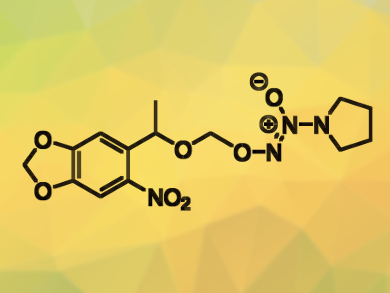Nitric oxide (NO) is a key neurotransmitter in vertebrates. Together with another signalling molecule called cyclic guanosine monophosphate (cGMP), NO regulates several (patho)physiological processes. Due to the short lifetime of NO of only a couple seconds, regulation of its levels is particularly challenging and also locally restricted. Therefore, substances that release NO by a special trigger are highly interesting to study NO/cGMP-related processes.
Thorsten Stafforst, University of Tübingen, Germany, and colleagues have developed a method to examine and regulate NO/cGMP signalling in a controlled manner using an optical trigger. Specifically, the team synthesized a photoprotected NONOate (pictured). This compound releases NO with high quantum yield after activation with UV light.
This 6-nitropiperonyloxymethyl (Npom)-protected NONOate is able to induce burst-like increases in cGMP concentrations in primary vascular smooth muscle cells. The team monitored this effect live by a genetically encoded FRET-based cGMP sensor and validated it by the phosphorylation of a downstream target. Due to the easy synthesis and the fast and efficient cGMP activation, Npom-protected NONOates could become a valuable tool to study NO/cGMP signaling with enhanced spatiotemporal resolution.
- Npom-protected NONOate enables light-triggered NO/cGMP signalling in primary vascular smooth muscle cells,
Anna Sofia Stroppel, Michael Paolillo, Thomas Ziegler, Robert Feil, Thorsten Stafforst,
ChemBioChem 2018.
https://doi.org/10.1002/cbic.201700683




